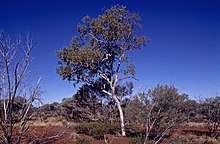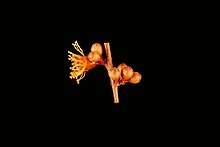Corymbia ferriticola
Corymbia ferriticola, commonly known as the Pilbara ghost gum,[2] is a species of tree or a mallee that is endemic to Western Australia. It has smooth bark, lance-shaped adult leaves, flower buds in groups of seven, creamy white flowers and shortened spherical to cylindrical fruit.
| Pilbara ghost gum | |
|---|---|
 | |
| Corymbia ferriticola in the Gibson Desert | |
| Scientific classification | |
| Kingdom: | Plantae |
| Clade: | Tracheophytes |
| Clade: | Angiosperms |
| Clade: | Eudicots |
| Clade: | Rosids |
| Order: | Myrtales |
| Family: | Myrtaceae |
| Genus: | Corymbia |
| Species: | C. ferriticola |
| Binomial name | |
| Corymbia ferriticola | |
| Synonyms[1] | |
| |


Description
Corymbia ferriticola is a straggly tree or mallee that sometimes grows to a height of 15 m (49 ft), often much less, and forms a lignotuber. It has powdery, white to pink bark weathering to light brown, sometimes with rough, grey, tessellated bark at the base. Young plants and coppice regrowth have heart-shaped, egg-shaped or lance-shaped leaves that are 35–80 mm (1.4–3.1 in) long and 13–37 mm (0.51–1.46 in) wide on a short petiole. Adult leaves are arranged alternately, lance-shaped, sometimes wavy, 40–100 mm (1.6–3.9 in) long and 6–22 mm (0.24–0.87 in) wide tapering to a petiole 3–12 mm (0.12–0.47 in) long. The flower buds are arranged in leaf axils on a branched peduncle up to 2 mm (0.079 in) long, each branch of the peduncle with seven buds on pedicels 2–5 mm (0.079–0.197 in) long. Mature buds are pear-shaped, 4–5 mm (0.16–0.20 in) long and 3–4 mm (0.12–0.16 in) wide with a flattened operculum. Flowering has been observed in December and January and the flowers are creamy white. The fruit is a woody shortened spherical to cylindrical capsule 6–10 mm (0.24–0.39 in) long and 4–9 mm (0.16–0.35 in) wide with the valves enclosed in the fruit.[2][3][4][5]
Taxonomy and naming
Pilbara ghost gum was first formally described in 1986 by Ian Brooker and Walter Edgecombe in the journal Nuytsia and was given the name Eucalyptus ferriticola.[6][7] In 1995 Ken Hill and Lawrie Johnson changed the name to Corymbia ferriticola.[4][8]
Distribution and habitat
Corymbia ferriticola mainly grows on ironstone hills, in gorges and on steep slopes in the Pilbara region, with scattered populations near Mount Augustus, Meekatharra and the Gibson Desert.[3][2][5]
Conservation
This eucalypt is classified as "not threatened" by the Western Australian Government Department of Parks and Wildlife.[3]
See also
References
- "Corymbia ellipsoidea". Australian Plant Census. Retrieved 10 February 2020.
- "Corymbia ferriticola (Brooker & Edgecombe) K.D.Hill & L.A.S.Johnson, Telopea 6: 446 (1995)". Euclid. Centre for Australian National Biodiversity Research. Retrieved 6 June 2020.
- "Corymbia ferriticola". FloraBase. Western Australian Government Department of Parks and Wildlife.
- Hill, Kenneth D.; Johnson, Lawrence A.S. (13 December 1995). "Systematic studies in the eucalypts. 7. A revision of the bloodwoods, genus Corymbia (Myrtaceae)". Telopea. 6 (2–3): 446–448. doi:10.7751/telopea19953017.
- Chippendale, George M. "Eucalyptus ferriticola". Australian Biological Resources Study, Department of Agriculture, Water and the Environment, Canberra. Retrieved 10 February 2020.
- "Eucalyptus ferriticola". APNI. Retrieved 10 February 2020.
- Brooker, M. Ian H.; Edgecombe, Walter B. (1986). "Eucalyptus ferriticola and E. pilbarensis (Myrtaceae), two new species from the Pilbara region of Western Australia". Telopea. 3: 373–376. Retrieved 10 February 2020.
- "Corymbia ferriticola". APNI. Retrieved 10 February 2020.